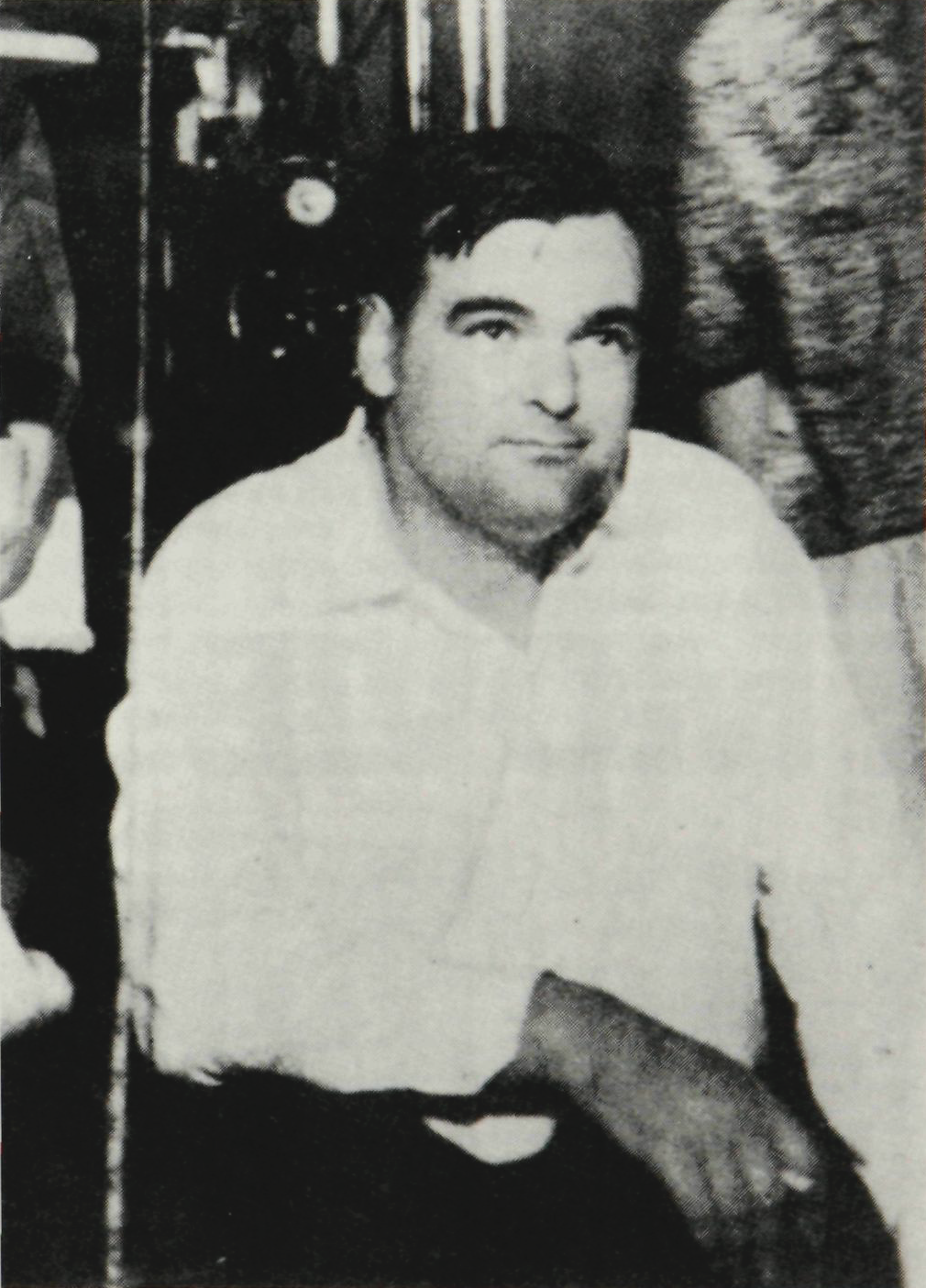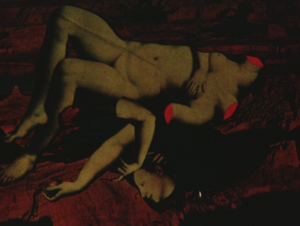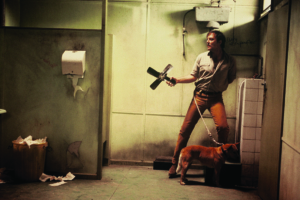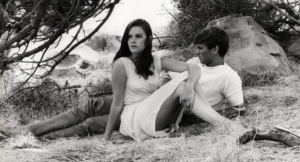The Early Life and Works of Cecil Holmes
In his 1981 article entitled ‘Australian Left Film History’, Charles Merewether opens with some pertinent words about how we in Australia are more familiar with the oppositional film culture and independent film practice of Europe and America than we are with our own.[1]Charles Merewether. ‘Australian Left Film History’. Filmnews. August 1981 reprinted in Albert Moran and Tom O’Regan (eds.) An Australian Film Reader. Sydney Currency Press 1985 p. 338. Here we are in 1994 and this blindness of Australian film culture to its strong left film tradition has remained. Our film history has suffered from the lack of writings addressing the work of Cecil Holmes and that it has taken his recent death for some interest to be generated says much about the state of film history in this country.
Holmes’ oeuvre stands as testament to an irascible and tenacious left wing character. Often the victim of repressive governments, institutional constraints and erratic economies Holmes pursued his filmmaking with ingenuity and an inventiveness for bringing projects to fruition.
One aspect of Holmes’ work, as a whole, that interests me is the radical film practice that is evidenced in his early films made in Australia. Captain Thunderbolt, Three in One, and Words for Freedom stand as remarkable films reflecting the much buried tradition of left cultural production in Australia. It is across the scope of these three films that it is possible to see a shift from the socialist realism of Captain Thunderbolt to an indication of European art cinema in the later section of Three in One. It is these films as well as the early influences on Holmes that I would like to address as an introduction and tribute to the persona, and fragmented history of the much larger Cecil Holmes.
Some kind of beginning can be made in the world wide rise of Fascism and the response of progressive minded people.
Holmes elucidates.
Seen in a universal context, it’s a period, doesn’t matter whether you’re living in New Zealand or anywhere else, in the Western world the influences were great upon people, especially of my generation, people in their teens and twenties just leaving school, because of the Spanish civil war and the fight against Fascism there, the rise of Hitler, the rise of Japan in the Pacific, the other major Fascist power, and the positives such as Roosevelt’s New Deal which gave great heart to progressive minded people, the conflicts in England within the left, the Labor party versus the rising communist party and the reactionaries still digging in… The natural thing to do was move to the left.[2]Cecil Holmes. Personal Interview. 25/8/’93. All unreferenced quotations refer to this interview.
Holmes’ singular film oeuvre displays a convergence of this “universal context” of left politics and of the quest for regional identity, something that Holmes responded to before migrating to Australia in 1948. This sense of regional identity had its beginnings in Holmes early interest in film culture.
I saw every Ken Hall and Charlie Chauvel film which also had a cultural effect and made you aware of your Australasian roots.
When asked about major filmic influences Holmes has consistently cited his witnessing of a double bill of Watt and Wright’s Nightmail and Hitchcock’s The Thirty Nine Steps in his home town of Palmerston North – an experience that led him to want to make films. “It had a dramatic effect upon me. I saw the magic of cinema and wanted to be involved”. But it was during the war when on shore leave in England that Holmes gained one of his most treasured experiences. Through some letters of introduction Holmes was able to spend time at Alexander Korda’s Denham Studios in England meeting and watching at work directors David Lean, Carol Reed, Anthony Asquith and Leslie Howard. At this time Holmes also whet his appetite for documentary in conversations with the protagonists of the British documentary movement Wright, Watt and Cavalcanti who “had all been in the position themselves of wanting to do something so if some young fella comes along from the colonies they’re quite happy to pass the time of day with him and talk.” The experience of the range of British film production at its peak, from the studio productions of Lean and Reed to the committed documentary practice of Wright and Cavalcanti has its residue in the film work Holmes himself was later involved in.
While Holmes was serving with the Royal New Zealand Airforce and then the Navy, John Grierson visited New Zealand, setting up almost immediately the National Film Unit producing ten minute newsreels entitled Weekly Review. In 1945 Holmes returned to New Zealand and, although there were no vacancies, managed to hang around the National Film Unit “teaching myself how to splice a film and use a Moviola in the lunch hour”[3]Cecil Holmes. One Man’s Way. Penguin 1986 p. 30. long enough to get himself at first some unpaid work and later a position as newsreel editor and later director. His film The Coaster (1947) Holmes described as “a bit derivative”, following the Griersonian formula expressed in Nightmail that had so impressed him on that night in Palmerston North.
Most of the films that Holmes was involved in in those days were the newsreels that Grierson had recommended the National Film Unit begin its production with.
By the end of the war the tranquil existence of the ex-servicemen in the Film Unit came to be undermined by “an editorial policy that followed a political agenda” and employees had become “restive”.[4]John O’Shea. ‘A Charmed Life: Fragments of Memory … and Extracts from Conversations’ in Jonathan Dennis and Jan Bieringa (eds.) Film in Aotearoa New Zealand. Wellington Victoria University Press 1992 p. 23. Holmes seems like an obvious target for the undercurrent of discontent and emerging anti-communist sentiment. Holmes’ run-in with New Zealand authorities occurred in 1948 when, as the Unit’s union representative, he was approached by John Mallitte,
a very conservative chap actually and he said I’ve got to go up in that Tiger Moth and take some pictures and he said why should I have to pay my own bloody insurance and I thought, oh yeah, that’s a good cause so we had a meeting and the Government wouldn’t budge so we had a strike; a stop work. Of course we were pretty discontented, nobody was being paid much money, people working hard and the public service is inimical to creativity. So you had a conflict such as people experience, or used to, at Film Australia.
Not only did Holmes instigate the first strike in the history of the New Zealand Public Service but he became the subject of events known as ‘the Cecil Holmes satchel affair’ which became infamous in New Zealand film and political history.[5]New Zealand Filmmaker and Academic Annie Goldson has received a Documentary Fellowship to make a film centred around these events. The story emanates from the kind of fear that created the McCarthyism that was emerging in the U.S. and was creeping into Australia and New Zealand at the time.[6]In 1949 the Menzies government was elected on a policy which included the banning of the Communist party. The bill was put to a referendum in September 1951 in which the government was defeated. see Robin Gollan Revolutionaries and Reformists: Communism and the Australian Labour Movement 1920-1955. Canberra ANU Press 1975 pp. 255-284. Holmes became something of a legend.
I had a satchel with letters, papers, whathaveyou. This was stolen out of my car which included a letter about the strike to the President of the Union which was written in a rather idiosyncratic, perhaps unfortunate way; a personal letter and this was released to the press and printed on the front pages. It didn’t serve me very well in the eyes of the public. People didn’t mind too much about that. The Government rather overstepped the mark and people realised that it wasn’t very nice to go around stealing people’s personal possessions and putting them in the newspapers or whathaveyou. So the tide turned against the Government.
Holmes had used official stationary in the correspondence and the Government took the line that, as a well known member of the Communist party, Holmes was manipulating the nation’s largest trade union. Over the ensuing year the Government, with public opinion rising against it, was eventually taken to and defeated in the Supreme Court by the Public Service Association. The Government was ordered to pay Holmes a year’s back pay and to reinstate him. During this time Holmes did not remain idle.
Due to black bans placed on him he couldn’t get paid work so he turned his attention to New Zealand’s long running Carpenters Union strike. Holmes approached the Union and made the film Fighting Back (1948) which can be seen as Holmes’ first move into radical film making. Holmes visited Victoria during this time where he had the negative processed and the soundtrack added with assistance from the Building Workers Industrial Union.
After the completion of Fighting Back and the end of the court case Holmes left New Zealand permanently for Australia where he had been in contact with John Heyer, then with the Commonwealth Film Unit and about to embark on his new role as head of the Shell Film Unit. Heyer was busy in pre-production for what was to be the Unit’s finest film The Back of Beyond (1953) and asked Holmes to script and direct The Food Machine (1952). Holmes remarks in One Man’s Way how Heyer “drove him to despair” with the attention to detail and preparation that characterised his own film work and that he required from others.[7]Cecil Holmes. One Man’s Way. Penguin 1986 p. 36. Holmes was also extremely grateful for the opportunity that Heyer provided.
He didn’t have any hang ups about politics. He couldn’t have cared less. We just talked about films. He is a tremendous film person. He eats, drinks and sleeps it.
Holmes’ experience at the hands of the New Zealand Government and his left politics cemented his name in left circles and it was with the agency of left organisations in Australia in particular the New Theatre in Sydney that Holmes became a driving force in Australian left culture. After working with Heyer at Shell Holmes began work on three of his most exemplary works.
Captain Thunderbolt (1953), Words for Freedom (1956) and Three in One (1957) employ the tenets of Australian left cultural production of the late 1940s and early 1950s and remain as documents tracing the surge in a particular nationalist sentiment seen by the left as the possible source of class consciousness. A major component of this resurgence was drawn from Australian folk songs.
Captain Thunderbolt, Holmes recalls, was inspired by Frank Clunes’ The Wild Colonial Boys and certainly the folksong of the same name which provides the basic narrative and of course the theme song.[8]Frank Clune. The Wild Colonial Boys. Sydney Angus and Robertson 1970. Holmes’ first feature was shot with the help of fellow New Zealand radio personality Colin Scrimgeour at Sydney’s Pagewood Studios. With actors of the quality of Grant Taylor and Charles Tingwell and a sizeable budget the director remembered the leap from short documentaries to feature film production as being sizeable.[9]Ibid. pp. 37-38. Although the film provides a clumsy mix of po-faced political drama, rollicking yarn and socialist realism it also has a brashness and thorough confidence in its construction. Cunningham comments.
Thunderbolt, it seems to me, is a particularly confident, stylistically and politically radical short fiction for a feature directorial debut … It is undoubtedly the best treatment of the highly censored ‘bushranger’ theme in the Australian cinema. It displays economical narratorial control with strong, even flashy, trans-sequential linking devices – the gun aimed at the spectator, shock pans and cuts, musical riffs, and the ‘Wild Colonial Boy’ montage sequence – and emphatic cut-aways, lighting effects, framing and camera movement.[10]Stuart Cunningham. Op. cit. p. 95.
Words for Freedom is a short documentary that was financed by The Tribune workers newspaper, the “voice of the progressive movement and the unemployed” and is a history of the workers press in Australia. The film is a romantic survey of union achievements and worker solidarity, from Eureka Stockade to the present including many references to Henry Lawson and drawings of Eureka Stockade as well as the story of Max Thomas and Thomas Ratliff, Communist Party members imprisoned in 1942. Leonard Teale provides the verse commentary written by Judith Wright. In its celebration and romanticisation of working class life, tied to recurrent tunes like ‘Click go the Shears’, Words for Freedom can be seen as a linking work between Captain Thunderbolt and Three in One.
Tom O’Regan has pointed to the apparent lack of analysis of the relationship between Australian film and theatre. Holmes’ early film work in Australia displays the manner in which left cultural production turned to the folk tradition in poetry and song emerging in left theatre to rekindle a nationalist fervour. While O’Regan addresses the significance of the presence of John McCallum introducing the stories of Three in One, it is Holmes’ association with Sydney’s New Theatre which reveals more about the cultural milieu which Holmes tapped into and propounded.[11]Tom O’Regan. ‘The Historical Relations Between Theatre and Film: The Summer of the Seventeenth Doll‘ Continuum. 1:1 pp. 116-120. It is no coincidence that the New Theatre’s quest to compose the quintessential Australian play resulted in Dick Diamond’s Reedy River (1954), the first ‘Australian musical’ which included songs like ‘Click go the Shears’, ‘Flash Jack from Gundagai’ and ‘The Old Black Billy’.[12]Thanks to Bob Matthews (Realist Film Unit member and director of initial 1954 Sydney New Theatre production of Reedy River) for pointing this out to me. More overt indications of the crossover between theatre and film include the superb performances of Eddie Allison; a New Theatre luminary, Jock Levy; New Theatre actor and later member of the Waterside Workers Federation Film Unit and New Theatre associate Leonard Teale in Three in One.[13]Holmes can be given some credit for the emergence of the Waterside Workers Federation Film Unit. As Director of the 1952 Eureka Youth League Carnival in Sydney, Holmes asked Bob Matthews and Keith Gow to film proceedings. The resulting film They Chose Peace (1952) saw Matthews hand Gow a 16 mm camera for the first time. Gow with Jock Levy and Norma Disher went on to set up the WWFFU. Other indications include the narration of Teale and the verse scripting of Catherine Duncan in Words for Freedom.
Holmes was approached by Frank Hardy who was keen to realise on film an adaptation of his short story The Load of Wood and could provide some money derived from the sales of Power without Glory. Upon the completion of the film of Hardy’s story Holmes and Scrimgeour decided to expand the project to include two other narratives which would frame the initial one. The first part, Joe Wilson’s Mates, based on Lawson’s short story The Union Buries its Dead, relies on the import of Lawson’s work where the ideals of mateship and solidarity are personified in the figure of Tom Stevens (Eddie Allison) and his mates.
While Heyer’s The Back of Beyond can be seen as a” peculiar adaptation” of the Grierson tradition, Three in One can be seen as a movement in three parts from the overt folk mythology of Thunderbolt to an invocation of Italian Neo-Realism distilled through Holmes’ left wing.[14]Ross Gibson. ‘On The Back of Beyond’ interview with Tom O’Regan, Brian Shoesmith and Albert Moran. Continuum. 1:1 1987 p. 83. As Sylvia Lawson points out, Australian cinema was able to produce a way of imaging “its wharves, markets, streets and slum terraces, its way of lounging on corners and gossiping at fences” that pre-empted the emergence of the term ‘neo-realism’.[15]Sylvia Lawson. “Not for the Likes of Us’ in Albert Moran and Tom O’Regan (eds.) An Australian Film Reader. Sydney Currency Press 1985 p. 154. Yet Holmes still pointed to an interest in the cinema of De Sica and Rossellini.[16]Cecil Holmes. Interview with Graham Shirley. AFTRS 21/1/’80. The third section The City employs cityscapes of Sydney and the story of Ted (Brian Vicary) and Cathie (Joan Landor) in a tale of alienation and anxiety about the future. The film concludes on a promising note but as Shirley and Adams point out “life in the city is shown to lack the sense of mateship that has sustained the protagonists of Joe Wilson’s Mates and The Load of Wood.”[17]Graham Shirley and Brian Adams. Australian Cinema: The First Eighty Years. Revised Edition Sydney Currency Press 1989 p. 190. The linear movement across time in Three in One, suggests a longing for the solidarity and ideals present in Captain Thunderbolt and Words for Freedom and the earlier sections of Three in One.
The 1950’s is noted for the low number of feature films produced in Australia yet Holmes’ films of the period, along with The Back of Beyond and Maslyn Williams’ remarkable Department of Interior ‘feature’ Mike and Stefanie (1952) remain as singular achievements in Australian film history.[18]see Tom O’Regan ‘Australian Film in the 1950s’ Continuum. 1:1 1987 pp. 1-25.
From 1960 Holmes was involved in over 20 film productions, many as director. He worked for the ABC making I, the Aboriginal and An Airman Remembers, for Film Australia as a Senior Director, directed many documentaries including two dramatised documentaries The Islanders and Gentle Strangers, the Institute of Aboriginal Studies with Return to the Dreaming and White Men in Black Skins, made Lotu and Faces in the Sun with the Methodist Overseas Missions and for other institutions. Holmes worked with filmmakers Esben Storm and Donald Crombie, gave lectures at AFTRS, screened documentaries to a young Bruce Beresford and gave a young student called Phil Noyce an early opportunity to work on a film crew.
A few months before his death I received a letter from Cecil which indicated his displeasure at being hounded by researchers before he “dropped off the twig” because it was getting in the way of his work. He wrote of his recently completed book Mask of Smiles and a recently completed screenplay entitled Mackie’s in Town, about Mt. Isa union boss Pat Mackie. Holmes’ reticence, despite his immense contribution to Australian film culture, speaks much about his insistence on the primacy of his film practice, which will hopefully be further addressed to raise it to the level of visibility it cries out for.
Cecil Holmes Filmography
New Zealand Films
Power from the River (1947)
The Coaster (1947)
Fighting Back (1948)
Australian Films
The Food Machine (1952)
Safari (1952)
Terrific the Giant (1952)
Captain Thunderbolt (1953)
Words For Freedom (1956)
Three in One (1957)
Lotu (1962)
An Airman Remembers (1963)
How They Shall Hear (1964)
The Lorrkun
Djalambu (1965)
The Ubar
Faces In The Sun (1965)
Islanders (1968)
Return to the Dreaming (1971)
Gentle Strangers (1972)
White Men in Black Skins
Yabadarawa
Ronan’s Country
A Matter of Care
Gold on Blue (1978)
Goddess and the Moon Man (1980)
Bitter Rice (1989)
Endnotes
| 1 | Charles Merewether. ‘Australian Left Film History’. Filmnews. August 1981 reprinted in Albert Moran and Tom O’Regan (eds.) An Australian Film Reader. Sydney Currency Press 1985 p. 338. |
|---|---|
| 2 | Cecil Holmes. Personal Interview. 25/8/’93. All unreferenced quotations refer to this interview. |
| 3 | Cecil Holmes. One Man’s Way. Penguin 1986 p. 30. |
| 4 | John O’Shea. ‘A Charmed Life: Fragments of Memory … and Extracts from Conversations’ in Jonathan Dennis and Jan Bieringa (eds.) Film in Aotearoa New Zealand. Wellington Victoria University Press 1992 p. 23. |
| 5 | New Zealand Filmmaker and Academic Annie Goldson has received a Documentary Fellowship to make a film centred around these events. |
| 6 | In 1949 the Menzies government was elected on a policy which included the banning of the Communist party. The bill was put to a referendum in September 1951 in which the government was defeated. see Robin Gollan Revolutionaries and Reformists: Communism and the Australian Labour Movement 1920-1955. Canberra ANU Press 1975 pp. 255-284. |
| 7 | Cecil Holmes. One Man’s Way. Penguin 1986 p. 36. |
| 8 | Frank Clune. The Wild Colonial Boys. Sydney Angus and Robertson 1970. |
| 9 | Ibid. pp. 37-38. |
| 10 | Stuart Cunningham. Op. cit. p. 95. |
| 11 | Tom O’Regan. ‘The Historical Relations Between Theatre and Film: The Summer of the Seventeenth Doll‘ Continuum. 1:1 pp. 116-120. |
| 12 | Thanks to Bob Matthews (Realist Film Unit member and director of initial 1954 Sydney New Theatre production of Reedy River) for pointing this out to me. |
| 13 | Holmes can be given some credit for the emergence of the Waterside Workers Federation Film Unit. As Director of the 1952 Eureka Youth League Carnival in Sydney, Holmes asked Bob Matthews and Keith Gow to film proceedings. The resulting film They Chose Peace (1952) saw Matthews hand Gow a 16 mm camera for the first time. Gow with Jock Levy and Norma Disher went on to set up the WWFFU. |
| 14 | Ross Gibson. ‘On The Back of Beyond’ interview with Tom O’Regan, Brian Shoesmith and Albert Moran. Continuum. 1:1 1987 p. 83. |
| 15 | Sylvia Lawson. “Not for the Likes of Us’ in Albert Moran and Tom O’Regan (eds.) An Australian Film Reader. Sydney Currency Press 1985 p. 154. |
| 16 | Cecil Holmes. Interview with Graham Shirley. AFTRS 21/1/’80. |
| 17 | Graham Shirley and Brian Adams. Australian Cinema: The First Eighty Years. Revised Edition Sydney Currency Press 1989 p. 190. |
| 18 | see Tom O’Regan ‘Australian Film in the 1950s’ Continuum. 1:1 1987 pp. 1-25. |





